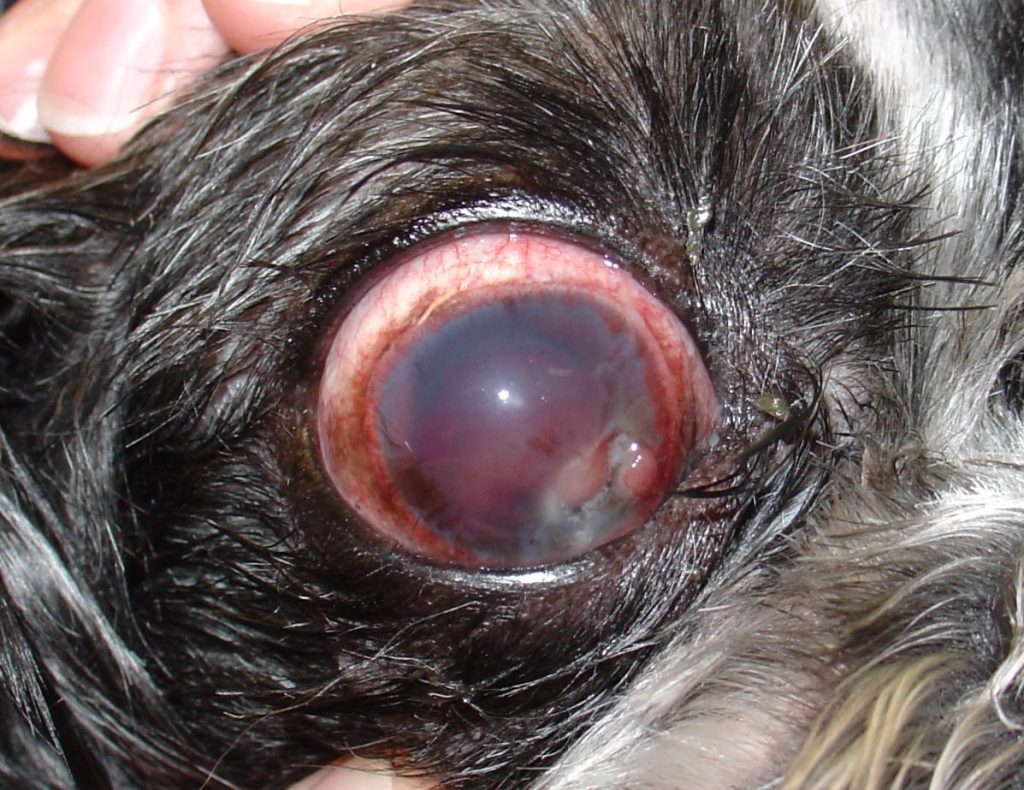Cloudy eyes in dogs are seen as a normal problem, especially the aged ones. But cloudy eyes can indicate an underlying health condition and in other cases indicate problems to the eyes only. In whichever the case, you should take immediate action whenever you notice cloudy eyes in your dog.
A dog can have cloudy eyes because due to Lenticular Sclerosis, Pannus, Glaucoma, Cataracts, Ulcer in the Cornea, Corneal Dystrophy, and Eye Ulcers.
Read on to understand more about the causes of cloudy eyes what you can do to prevent it and the cost of treating cloudy eyes.
7 Causes Of Cloudy Eyes In Dogs
Lenticular Sclerosis
It’s natural for a dog’s vision to decline as he gets older. Lenticular sclerosis develops as your dog’s body reacts to a series of predictable changes. As the fibers in your dog’s lens shrink, they cause the lens to become harder and cloudier. This is something that all dogs go through as they get older. Although lenticular sclerosis is linked to the development of cataracts, it is a separate disorder.
Pannus
Pannus is a disease that mostly affects large breed dogs. It resembles Keratoconjunctivitis sicca in appearance, but dogs with pannus show typical tear production and are not in pain. Because the lesions cover the cornea, they might hinder vision.
Telling the difference between the two is easy using a strip of paper to measure the amount of tears produced. A healthy dog should wet not less than 15 millimeters of the strip that is put inside the lower eyelid for a minute.
Also Read: 7 Rare Dog Diseases
Glaucoma
Glaucoma is a disorder in which an excessive amount of fluid accumulates within the eye, causing increased pressure. In addition to being irritating for your dog, glaucoma causes 40 percent of canines to go blind within a year. A genetic mutation causes primary glaucoma, but trauma such as an infection, an injury, or a tumor causes secondary glaucoma. While any dog can acquire secondary glaucoma, several breeds, such as Chow Chows and Siberian Huskies, are genetically prone to primary glaucoma.
Cataracts

Cataracts can occur in dogs as they age, just as they can in humans. The proteins in your dog’s eye move closer together than they should, causing this disorder. A multitude of causes can induce cataracts, including aging, eye damage, eye sickness, and diabetes. Cataracts are more common in some breeds, such as the poodle and schnauzer.
Cataracts can cause your dog’s vision to deteriorate over time, causing him to lose all or part of his vision. Although there is no effective treatment for canine cataracts, most dogs can live out their golden years without their cataracts showing a detectable problem.
Ulcer in the Cornea
If abrasions or lacerations on your dog’s cornea go untreated, they can turn into ulcers. As the most visible portion of the eye, the cornea is necessary for maintaining your dog’s eye safety and health. The cornea has acquired an entrance to the internal parts of your dog’s eye when an ulcer forms. Corneal ulcers are more common in dogs with protruding eyes, such as Boxers and Shih Tzus.
Corneal Dystrophy
Some dog breeds are more susceptible than others to this illness. It’s also hereditary meaning it can be spread to the puppies. Depending on the dog and genes involved, corneal dystrophy can damage various parts of the eye.
Canine do not have vision problems as a result of this disease, but it can develop ulcers that require antibiotic treatment. Corneal dystrophy, on the other hand, cannot be cured and must be handled for the remainder of your dog’s life.
Eye Ulcers
Eye ulcers can be triggered by a variety of things, but they’re most commonly caused by scratches or other wounds to the eyeball. They are infections in the eye that must be treated with medication. They cause a dog’s eyes to become cloudy, reddish, and itchy, as well as painful.
Whilst eye ulcers can be dangerous if left untreated, they are simple to treat if you take your dog to the veterinarian as soon as possible. Take him to the vet as soon as he begins to experience soreness or tears in his eye.
Prevention of Cloudy Eyes In Dogs
The method of prevention of cloudy eyes will depend on the main cause. Cloudy eyes due to old age cannot be prevented in any way and shouldn’t get you worried. The same applies to lenticular sclerosis.
Some disorders like eye ulcers can be prevented by keeping your dog safe from injuries and trauma. Many of the above disorders can be prevented from proceeding to the last stage where they cannot be managed. The advisable thing to do is take your pooch to the vet twice per year to have an eyes checkup.
Cost Of Treating Cloudy Eyes In Dogs
The cost of treating this disease will vary depending on its main cause. The average cost of medical care for lenticular sclerosis is $250, while the average cost of medical care for corneal ulcers is $350. Treatment for glaucoma costs an average of $900, whereas cataract surgery costs an average of $2500.
Conclusion
There are many causes of cloudy eyes in dogs from aging, trauma, infections to inheritance. There is no specific formula to prevent cloudy eyes, but if you can cooperate with your vet you can get the best solution and prevention method.
If it is caused by aging, your vet can recommend certain types of food to slow down his aging rate among other solutions.
Other Related Articles;

